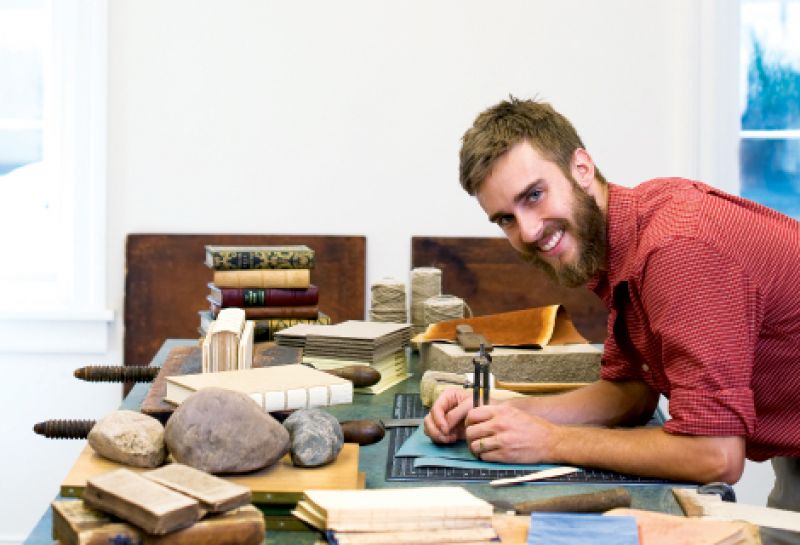
In the summer of 2012, the Charleston Library Society hired now-23-year-old Brien Beidler as its first full-time book binder, then equipped him with nipping presses and sewing frames—the tools of his antiquarian trade. In his King Street studio, he conserves, repairs, and rebinds books from the library’s expansive collection. He also bound 15 facsimile editions of John Drayton’s 1789 The Carolinian Florist that are being sold to raise funds for the 265-year-old institution. His services are available to community members, who are welcomed in for workshops and even kids’ camps, helping him share his exuberance for ancient texts and an age-old craft.
CM: What started you on the road to becoming a book binder?
BB: It was an art class my sophomore year in high school. I was a Lord of the Rings junkie, and there was an assignment to make some sort of “book sculpture.” Of all the crafts I was interested in, I realized that I wanted to learn how to bind a book someday.
CM: So how did you take the next step?
BB: I was reading an old Rudyard Kipling book and the back cover tore off. I knew the College of Charleston’s library had fancy cloth tape, so I thought maybe they could help. They introduced me to Special Collections head Marie Ferrara. She was generous enough to invest time in teaching me how to bind.
CM: Do you worry that because modern books are rarely hand-bound, the market for your skills could eventually dry up?
BB: It’s not a dying art. I know of a binder who is working to develop techniques that can be done quickly and will make it affordable for people to buy new, hand-bound books. But right now, it is labor intensive.
CM: You seem to use a lot of natural tools.
BB: I make my own awls with wax myrtle wood and “folders” (for manipulating paper) with deer and elk bone. It’s neat that you can carve them to custom-fit a specific job. I even made one with petrified whalebone. You can look at wood engravings from hundreds of years ago and see people using the same types of tools for book binding. I’m also obsessed with rocks, so I use them when I need to weigh down papers or finished books.
CM: Do you enjoy leading the binding camps for kids?
BB: Yes, I love how addicting their energy is and how literal their minds are. For example, I told them we were going to make Japanese stab bindings, and all they heard was “stab.” I then had to spend the next few minutes trying to get them to stop fencing with cardboard scraps.
CM: What has been your favorite binding project so far?
BB: I really enjoyed binding a handwritten Civil War logbook for the CSS Shenandoah, which was a Confederate battleship. The history was so tangible.
CM: Is this a job you can see yourself doing 50 years from now?
BB: As of now, definitely. Never in my wildest dreams did I ever think I’d be able to bind books professionally right out of school. Every day I come to work and think of how lucky I am to be able to do what I wanted so soon in my life.